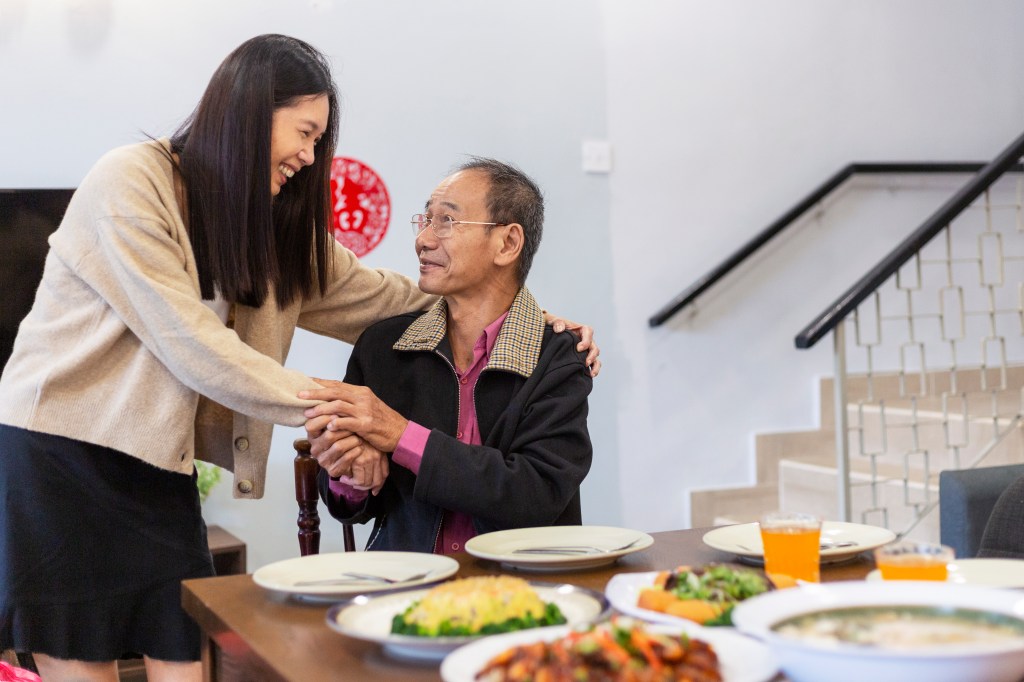
What Is A Medicaid Family Caregiver?
When your loved one qualifies for Medicaid, you may not realize that their benefits can go beyond basic medical coverage. Caring for a loved one at home helps Medicaid avoid the higher costs of care facilities, like nursing homes, so many states compensate caregivers for the work they’re already doing to support a Medicaid-eligible individual. In-home caregiving enhances a person’s quality of life and keeps them more connected to their community. This improves their health outcomes, both physically and mentally, which also reduces medical costs for the state.
If your loved one is Medicaid-eligible and you’re serving as their primary caregiver, it’s important to review what support services your state offers. Coaching, respite, and financial assistance may all be available if your loved one qualifies. While these services can benefit your mental, emotional, and physical well-being as a caregiver, they also improve the outcomes for your loved one by reducing falls, limiting ER visits, and improving their overall health and wellness.
Understanding the Role of a Family Caregiver
A family caregiver is a relative, friend, or neighbor who provides long-term care for a loved one. Family caregivers provide a variety of assistance with their loved one’s activities of daily living (ADLs). These activities can include meal preparation, dressing, bathing, mobility help, and more. Family caregivers are a crucial part of our nation’s care network, providing emotional, physical, and financial support to those who need care most.
While some families split caregiving responsibilities among several family members, it’s common for one member of the family to undertake much of the work. When a single family member takes the caregiving lead, it can streamline decision making, improve collaboration, and reduce tension among family members. The caregiver has the best line-of-sight into their loved one’s evolving needs, and they can raise concerns or issues with their care team and other family members when necessary.
What Does It Mean to Be a Medicaid Family Caregiver?
Learning what constitutes a full-time caregiver by Medicaid’s standards is the first thing to understand. An informal caregiver may reside in a different home from their loved one, may check in daily, or cook a meal a few times a week. They often ask the individual for updates on their mediations and may infrequently attend doctor’s appointments.
In contrast, a full-time caregiver is living with their loved one and managing most or all of their daily care needs. If this caregiver is not at home, they would likely require backup from a respite caregiver to manage their loved one’s ADLs in their absence. Frequently, this primary caregiver sacrifices other work to provide constant care for their loved one. They are present every morning to prepare their loved one for the day, managing medications, coordinating doctor’s appointments, and supporting their loved one’s social engagements.
For individuals providing these caregiver services, some states offer common programs and waivers to help. The Home and Community-Based Service (HCBS) waiver offers day services, respite care, and case management support that can guide and assist caregivers. Additionally, Consumer-Directed Personal Assistance Programs (CDPAP) frequently offer training, education, and resource support for caregivers.
Who Qualifies as a Medicaid Family Caregiver?
To qualify for Medicaid support, the person receiving care usually must live in the same home as the caregiver. Many programs also require the caregiver to assist with a set number of ADLs each day, such as bathing, dressing, or feeding. Additionally, age restrictions and eligibility criteria often apply depending on the specific Medicaid waiver or program.
Another key factor is the caregiver’s relationship to the person receiving care, which varies widely by state. Some states allow spouses, adult children, or close friends to serve as paid caregivers, while others place limits—particularly on spousal caregiving. Understanding your state’s full set of requirements is important, as rules can differ by both program and location.
What Support Does Medicaid Offer to Family Caregivers?
Through select Medicaid offerings, caregivers can receive support for the work they do, which may come in the form of caregiver coaching, designated care teams, financial assistance, resource access, support groups, respite assistance, and much more. Whether it helps offset a caregiver’s loss of pay from other work or assists with home modifications or durable medical supplies, financial compensation can significantly reduce stress and anxiety for caregivers. By surrounding caregivers with a support team and providing condition-specific resources and tools, their loved one benefits from improved care in the comfort of their own home.
How to Become a Medicaid Family Caregiver
Understanding if your loved one qualifies for Medicaid is your first step toward receiving support; the American Council on Aging has a valuable free Medicaid assessment tool. If your loved one is eligible, visit your state’s Medicaid website to identify the specific application process, which typically accepts applications online or in the mail. Many states also offer application support through the local Area Agency on Aging (AAA). Your local AAA can be found by using the Eldercare Locator site. From there, check the State Waivers List for HCBS or CDPAP offerings. Through these tools, you may find programs that align with your unique circumstances.
Depending on the state or specific Medicaid program, caregivers may be required to complete certain steps during the onboarding process. This can include formal assessments to evaluate the needs of the person receiving care, as well as mandatory training to ensure the caregiver is prepared to provide safe and effective support. These requirements are designed to uphold the quality of care and may vary by location and program.
Becoming a family caregiver through Medicaid can bring much-needed relief to family caregivers. “I’ve never had the support that I get from Careforth. They’re not just worried about my mom; they’re worried about my mental health. They ask me how I am holding it together, am I getting the help I need, am I making sure I’m going to my doctor’s appointments. They make sure that I’m taking the time to make sure I’m good in order to take care of [my parents],” said Tiffany, caregiver to her parents, Georgia and David.
Empowering Family Caregivers Through Medicaid
Caregiving is a deeply human experience. It’s something nearly all of us encounter at different points in life, whether we’re providing care, receiving it, or both. At its heart, caregiving is an act of compassion. It’s about showing up for someone else, offering support, and helping make their daily life a little bit easier.
Remember that caregiving isn’t a journey to be taken alone—it requires support and teamwork. Without those critical pieces of the puzzle, a caregiver’s tank can empty quickly. At Careforth, we strive to provide the resources and connections that help caregivers feel supported at every turn in their caregiving journey. Learn how Careforth can help you become a Medicaid family caregiver.
Medicaid Family Caregiver FAQs
Does Medicaid pay family members to be caregivers?
Yes, certain family members can be compensated for their caregiving. Each state has specific criteria for caregivers to be paid for their work, which can include siblings, parents, adult children, friends, or neighbors. Some states may exclude spouses or legal guardians from eligibility. Reach out to Careforth to better understand your state’s specific program offerings.
Who qualifies to become a paid family caregiver under Medicaid?
Each state Medicaid program, and the accompanying waivers, have unique qualifications and limitations; however, if you are a live-in family member providing daily care to your Medicaid-eligible loved one, you may be eligible. Research programs and waivers available in your state.
How do I apply to become a Medicaid-paid caregiver for a family member?
The first step is to ensure your family member qualifies for Medicaid. You can visit the federal Medicaid site to be directed to your state’s application process. Once your loved one is enrolled in Medicaid, you can reach out to your local Area Agency on Aging (AAA) to understand what paid programs are available to you.
Can I be a caregiver for more than one family member under Medicaid?
Yes, in some cases, Medicaid programs do allow a caregiver to support more than one family member, as long as each individual meets eligibility requirements. This can vary by state and by program. It’s best to check with your state’s Medicaid office to understand what is allowed in your area and what is realistic based on the level of care each person needs.
More insights like this:
-

Medicaid Rules Every Family Caregiver Should Know
Read more: Medicaid Rules Every Family Caregiver Should KnowCaring for a loved one who relies on Medicaid can feel overwhelming, especially when you’re trying to sort through rules, services, and paperwork while also meeting daily care needs. More than 20% of people enrolled in Medicaid are either over the age of 65 or have a diagnosed disability. Yet this group accounts…
-

Medicaid Benefits for Caregivers in Massachusetts: What You Need to Know
Read more: Medicaid Benefits for Caregivers in Massachusetts: What You Need to KnowBeing a caregiver for a loved one is a great honor and one of the greatest challenges. Whether you’re slowly stepping into the role or took on the title overnight, caregiving for someone means ensuring their physical, mental, and emotional needs are met. This may be a difficult phase for the person receiving…
-

What is the South Dakota Medicaid HOPE Waiver?
Read more: What is the South Dakota Medicaid HOPE Waiver?The Home and Community-Based Options and Person Centered Excellence (HOPE) Waiver is a Medicaid waiver program supporting care for nursing home-eligible individuals in non-nursing home settings with the goal of reducing costs. The program makes it possible for qualifying elderly recipients to remain in community settings, such as their own homes or independent…